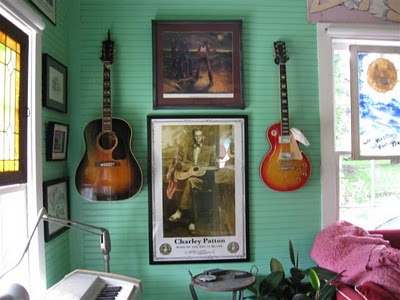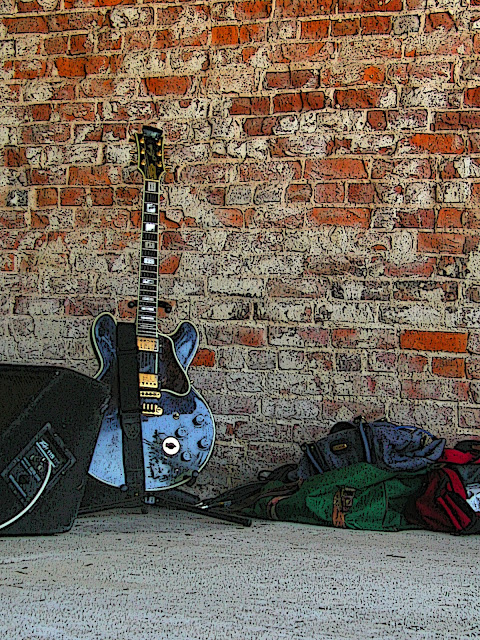When
the band Chicago released Color My World
in 1971, I was in 9th grade.
The languid cadence of the piano introduction was captivating and
beautiful. It’s been called the most
famous major seventh chord in the history of music, and it was — bar none — the
best slow-dance song of my generation.
One day in study hall I heard that chord being
played on the baby grand piano down in Coach Parker’s classroom. I went to see who was playing.
It
was a new kid – a shy young boy with jet-black locks that hung down in his eyes
as he played, totally lost in the music.
His name was Tommy Polk, and he’d picked the song out by ear. Feeling out of place, not knowing anyone and
not having an athletic bent, Tommy found refuge and release and friends through
music. Who doesn’t want to hang with the kid in the band?
“I
was never good at sports,” he says. “I was always on the sidelines and never
got any recognition. When I was about nine I took a guitar to class and played.
Everyone noticed. I was not on the sidelines; I was not overlooked or ignored.
I was hooked.”
When
he was old enough to drive, he took his guitar to a secluded spot on the bluff
where he would sit in the shade, the river a wide, shimmering ribbon down below
with the flat, Louisiana delta beyond. He
started writing songs — the first of hundreds.
Tommy
would make music his life. In that little classroom in this quiet little town
his journey had only just begun. He
moved to Nashville in 1979. In 1981 he
began working at a boutique music-publishing company co-owned by one of
Britain’s most successful songwriters, Roger Cook, and Canadian-born Ralph
Murphy. Between them they had written
huge hits, such as, I’d Like to Teach the
World to Sing; Long, Cool Woman in a
Black Dress; Here Comes that Rainy
Day Feelin’ Again; and Half the Way.
Under
Cook and Murphy, Tommy learned about music publishing, foreign publishing,
performing rights, copyrights, song plugging, signing writers, catalog
acquisition, demo recordings and record production.
“When
I left for Nashville in ‘79, I had written a hundred or so songs at that point.
I thought I was going to be the biggest thing since sliced bread,” he says
shaking his head. “Wrong! It would be
another 200 songs before I got my first substantial cut.”
In
1989 Tommy signed with Warner-Chappel Music Publishing where he stayed for four
years, after which he remained as a signed songwriter, as well as with various
publishing houses in Nasvhille, including EMI, Hamstein, The Farm, OMG/Acuff
Rose. He also has extensive catalogs at other publishing companies including
Sony Tree.
Some
of Tommy’s hit songs include Look What
Followed Me Home by David Ball; He
Feels Guilty to Me by Bobbie Cryner; I
Don’t Want You to Go by Carolyn Dawn Johnson; the recently released Beyond My Broken Dreams by Eden Brent;
and Willing to Crawl by Johnny Neel,
which was featured on HBO’s True Blood in 2009. He’s even written songs for Irma Thomas and Bobbly
Blue Bland.
“I
loved what I was doing,” he says. “I
couldn’t wait to get up in the morning.
It wasn’t work; it was play.”
Then
somehow things changed.
“I
don’t know,” he says. “It seemed like
the music business had become more cutthroat. People were downloading music off
the Internet, which really hurt financially, both for me and for everyone
else. Even the music changed. Performers
were writing their own songs rather than using songwriters. A lot of people were out of work. Perhaps I changed, too. It just wasn’t as much fun anymore.”
So
Polk switched gears, opening a one-of-a-kind B&B in Clarksdale, Mississippi,
called Shack-Up Inn with a couple of business partners.
“We
moved some sharecropper shacks onto my cousin’s cotton plantation and just
fixed them up enough to be livable.”
They
were simple, rough shacks, the kind where the original old blues players wrote
and performed their music — people like Son Thomas, John Lee Hooker, Robert
Johnson, Lead Belly and others. It was a
huge success.
“People
wanted the blues experience,” he said.
“And they came from everywhere — England, Germany, Japan and the United
States.”
It
dawned on him that Clarksdale had become a music-tourist destination. He
discovered he liked the hospitality business and opened three more. He decided to move to Clarksdale permanently
and bought a house for his mother there.
When
he came back to Natchez to sell his mother’s house in Vidalia, he looked around
and realized he didn’t want to cut all ties to his hometown.
+(Small).jpg) |
| Shantybellum |
“Natchez
is really one of the most beautiful towns in the world,” he says. “So I bought another shack to use as a B&B
and called it ‘Shantybellum.’ I figured
I could hire someone to run it here and have a place to stay when I came to
visit.”
 |
| Shantybellum reflected in the bottle tree |
While
restoring the house, though, he decided he really wanted to come home for
good. So he stayed, eventually selling
the B&B’s in Clarksdale and going to work as a consultant for the town of
Ferriday under Mayor Glenn McGlothin, a musician, himself.
“I
took Glenn to Clarksdale to show him what we’d done. He loved it.
And told him that with Ferriday’s musical heritage, I bet we could do
the same thing here.”
| Jerry Lee Lewis museum |
 |
| Photo courtesy of The Concordia Sentinel (used with permission) |
 |
| Will Haney |
Ferriday
is home to some remarkable music history.
Double-first cousins Jerry Lee Lewis, Mickey Gilley and Jimmy Swaggart
are native sons. For years Haney’s Big
House, which burned in 1966, had been a feature attraction on the Chitlin’
Circuit, hosting such notable African American entertainers as B.B. King, Moms
Mabley, Redd Foxx, Ray Charles and Bobby Bland.
After
witnessing smokestack industry pass up Ferriday as a place to do business for
years, McGlothin agreed on a new economic development plan focusing on tourism
and music tourism combined with a healthy dose of cultural-heritage tourism.
| Frogmore Plantation |
Building
on tourism assets already in the area like Frogmore Plantation, the Lewis
Family Museum, the Delta Music Museum and the Arcade Theater, they got
grants. The plan called for:
· The renovation of a
burned-out shell of a building into an open-air venue called Rockabilly Plaza,
which would also function as a farmer's market/music venue and arts center for
youth, and with original artwork/murals on exterior walls.
· The renovation of a
deteriorating railroad property into the Haney’s Big House Music Hall to
include a large, fully covered outdoor stage for festivals and events.
· The partial restoration
of an underutilized railroad building to be leased as a private club.
In
addition, Ferriday began hosting an annual songwriters workshop at the Arcade
for local songwriting hopefuls, bringing many of Tommy’s Nashville co-writers
to teach about the business and craft of music.
Ferriday also created and hosted the annual Soul Survivors Festival, honoring
Will Haney and Haney’s Big House and the musicians associated with Haney’s from
the 1940s until its destruction in 1966.
| Playing air guitar on a cane at the Soul Survivors Festival |
It
was an uphill job. McGlothin had to deal
with water issues and his own health issues as well. But they persevered. On May 22 at the
third-annual Soul Survivors Festival, McGlothin presided over a ribbon-cutting
ceremony at the new Will Haney’s Big House Music Hall and Jerry Lee Lewis
Rockabilly Park and Plaza, the renaming of First Street to Pee Wee Whittaker
Avenue, the naming of Will Haney Circle and the placement of seven historic
markers downtown honoring Ferriday’s past and people.
As
McGlothin’s mayoral term comes to a close, Tommy is looking ahead. He hopes to continue working as a consultant
in the area. He’s even going back to
songwriting.
“I’m
playing with a local band in Natchez called Back Roads,” he says. “I’m also beginning to write again
with two of my Nashville cowriters on Skype and putting lyrics on
prerecorded tracks sent as mp3 to me. High-tech Tommy songs.”
He
looks back on his time with McGlothin in Ferriday fondly.
| Mayor Glen McGlothin, left; Tommy Polk, right |
“I
am so glad Glenn asked me to come aboard. For four years now I've been able to
focus on music, even bringing Nashville friends and cowriters down to Ferriday,
and working on downtown development projects that I am so proud to have been a
part of.
“In
researching Haney's for Ferriday I learned that three of the headliners during
its heyday would record some of my songs. I loved learning that. Who
would’ve guessed it?
“We
will leave our babies behind for the next administration to nurture and grow
Ferriday into a music destination. The ball is in their court. I wish them
well. They have a tremendous tourism opportunity. I hope Mayor-elect Gene Allen will make the
most of it.”








I really enjoyed reading this!
ReplyDelete